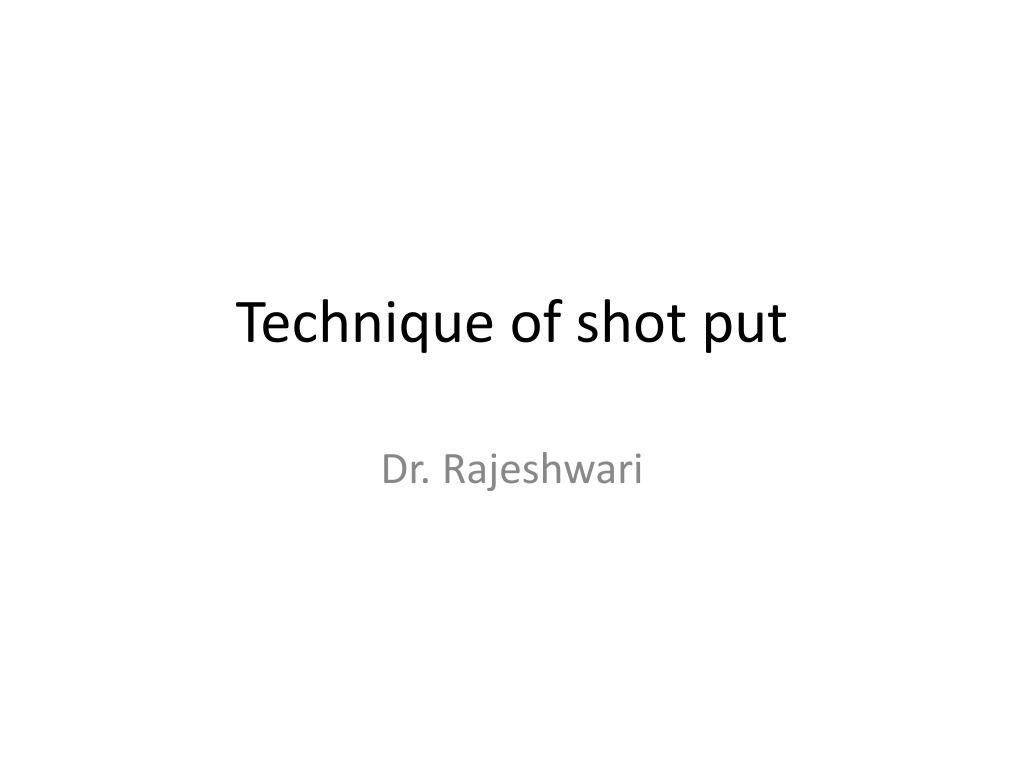Shot Put Technique Overview
Shot put technique involves specific steps from holding the shot correctly to the final throwing position. It includes holding the shot at the base of the fingers, raising it above the head, positioning the body correctly, and executing the throw with a focus on using the legs and hips effectively for maximum power and distance. Proper technique is crucial for success in shot put competitions.
Download Presentation

Please find below an Image/Link to download the presentation.
The content on the website is provided AS IS for your information and personal use only. It may not be sold, licensed, or shared on other websites without obtaining consent from the author. Download presentation by click this link. If you encounter any issues during the download, it is possible that the publisher has removed the file from their server.
E N D
Presentation Transcript
Technique of shot put Dr. Rajeshwari
Holding the shot The shot is held at the base of the fingers, not the palm. The fingers are slightly spread apart with the thumb for support The hand will be bent back in the cocked position when holding the shot. It looks like you are carrying a pizza.
Placement of the shot Raise the shot above your head. Lower the shot straight down until it is under your jaw. Push the shot into your neck. Lift your elbow parallel to the floor. Don't squeeze your elbow towards your back. Check to see that your thumb is pointing down towards your clavicle. The palm should be pointing towards the throwing direction.
Glide Position Stand at the back of the ring facing away from the throwing direction. Place shot against your neck. Put your body in an athletic position facing away from the sector. Extend your left arm out - relaxed. Extend the left leg back towards the toe board. Most of the body weight should be on the right leg.
Gliding into the final position Tap your left leg for balance. Draw up the left knee even with the right knee, remember to keep the left leg straight. Do not allow your left leg to curl behind the right leg. Allow your hips to start to fall. Violently extend your left leg towards the toe board, do not lift up with your back. Push and then pull your right leg underneath you, it will look like the last part of your body leaving the circle is your right heel.
Body position in the final position The thrower will stand perpendicular to the throwing direction. The feet position will be shoulder width apart or a little wider with left foot slightly behind the right foot (toe heel relationship). The right foot will be perpendicular to the throwing direction. The thrower needs to be in an athletic position. Power Position: The thrower will shift 80% percent of his/her weight onto the right leg. The thrower will twist his/her upper body completely opposite the throwing direction. This position from up above will look like an X. The chest, knee and toe should be in line with each other. The thrower places the shot into his/her neck. The left arm will be extended and out from the body with a right angle relationship to the right elbow.
Throwing(putting) from the final position Over exaggerate the use of the legs in the throw especially the hips. Sequence of the throw will be legs - hips - back - arm. Push the weight from right leg to the left leg in an upwards direction. When driving up with your legs your right heel (hips) needs to be turned out. There will be a stretch reflex reaction between your upper body and lower body. The upper body will start coming around. As your upper body comes around sweep the left arm around and then bring it tight to your body. Stop the left side of your body to aid in accelerating the shot.
Delivery of the shot Eyes to the ceiling. Punch the shot away from the neck. Keep the elbow high at all times. Lowering the elbow can cause the shot to be thrown like a baseball and could result in an injury. Finish the punch with a flip of the wrist. The left side of the body will be stopped and locked to help form the block. The left arm will be tucked close to the side of the body.























